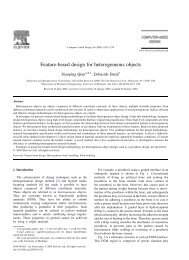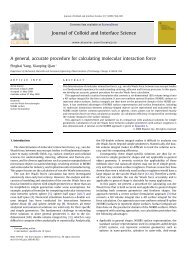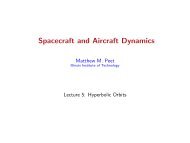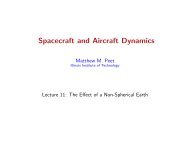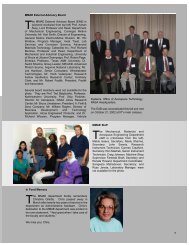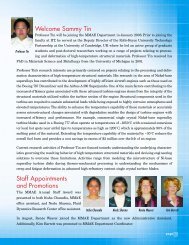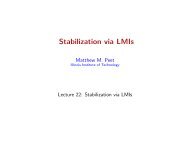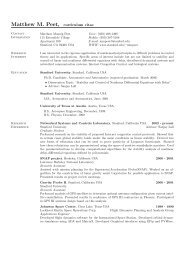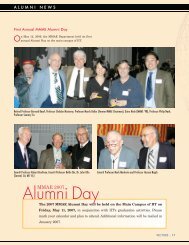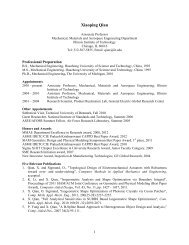Lecture 3 - Illinois Institute of Technology
Lecture 3 - Illinois Institute of Technology
Lecture 3 - Illinois Institute of Technology
You also want an ePaper? Increase the reach of your titles
YUMPU automatically turns print PDFs into web optimized ePapers that Google loves.
Spacecraft and Aircraft Dynamics<br />
Matthew M. Peet<br />
<strong>Illinois</strong> <strong>Institute</strong> <strong>of</strong> <strong>Technology</strong><br />
<strong>Lecture</strong> 3: Airfoils, and Static Stability
Aircraft Dynamics<br />
<strong>Lecture</strong> 3<br />
In this lecture, we will discuss<br />
Airfoils:<br />
• Nomenclature<br />
◮ Chords, Camber, Aerodynamic Center, etc.<br />
• Forces and Moments produced by lifting surfaces<br />
◮ Lift and Moment coefficients and how to interpret them.<br />
Static Stability:<br />
• Definition<br />
• How to determine static longitudinal stability<br />
M. Peet <strong>Lecture</strong> 3: 2 / 36
Next Subject: Lifting Surfaces<br />
How do they work???<br />
Figure: Airfoil as Cross-Section<br />
Many <strong>of</strong> the Forces on an aircraft are produced by Lifting Surfaces.<br />
• Major exception is propulsion.<br />
Lifting surfaces are characterized by<br />
Planform Shape: The shape <strong>of</strong> the wing when viewed from above.<br />
• Surface area, tapering, etc.<br />
• determines magnitude <strong>of</strong> forces.<br />
Airfoil: The cross-section <strong>of</strong> the wing.<br />
• Determines type <strong>of</strong> forces and moment.<br />
◮ Positivity, location, etc.<br />
M. Peet <strong>Lecture</strong> 3: Nomenclature 3 / 36
Lifting Surfaces<br />
Planform Shapes<br />
Planform Shape: The planform shape <strong>of</strong> the wing will<br />
affect<br />
• Lift<br />
• Drag<br />
• Moment<br />
Surface Area: As mentioned earlier, forces and<br />
moments are proportional to.<br />
F ∼ = C L QS<br />
and<br />
M ∼ = C M QSl<br />
Thus<br />
• Larger wings produce more lift and drag<br />
• Larger wings produce more Moment<br />
• More on chord length, l, shortly<br />
M. Peet <strong>Lecture</strong> 3: Nomenclature 4 / 36
Lifting Surfaces<br />
Planform Definitions<br />
In this course, we will assume a rectangular wing planform.<br />
Correction factors can be used for rounded or swept-wing configurations.<br />
Chord, c: The width <strong>of</strong> the surface at some point. This determines the size <strong>of</strong><br />
the airfoil.<br />
Root Chord, c r : The width <strong>of</strong> the surface where joined to the airplane.<br />
Tip Chord, c t : The width <strong>of</strong> the surface at free-stream.<br />
M. Peet <strong>Lecture</strong> 3: Nomenclature 5 / 36
Lifting Surfaces<br />
Planform Definitions continued<br />
Span, b: The total length <strong>of</strong> the surface.<br />
Quarter-Chord Line: The line connecting the points <strong>of</strong> 1/4 chord along the<br />
span <strong>of</strong> the surface. The 1/4 chord point is approximately the aerodynamic<br />
center <strong>of</strong> an airfoil - to be discussed<br />
Sweep: The angle the 1/4-chord line makes with the horizontal.<br />
M. Peet <strong>Lecture</strong> 3: Nomenclature 6 / 36
Lifting Surfaces<br />
Examples<br />
M. Peet <strong>Lecture</strong> 3: Nomenclature 7 / 36
Lifting Surfaces<br />
Examples<br />
M. Peet <strong>Lecture</strong> 3: Nomenclature 8 / 36
Lifting Surfaces<br />
Examples<br />
M. Peet <strong>Lecture</strong> 3: Nomenclature 9 / 36
Lifting Surfaces<br />
Examples<br />
M. Peet <strong>Lecture</strong> 3: Nomenclature 10 / 36
Lifting Surfaces<br />
Examples<br />
M. Peet <strong>Lecture</strong> 3: Nomenclature 11 / 36
Lifting Surfaces<br />
Examples<br />
M. Peet <strong>Lecture</strong> 3: Nomenclature 12 / 36
Lifting Surfaces<br />
Airfoils<br />
Figure: Airfoil with positive camber<br />
Chord Line: A line connecting the leading edge to the trailing edge.<br />
Camber Line: A line connecting the points halfway between the top and<br />
bottom surfaces.<br />
Camber: Camber refers to the difference between the chord line and the<br />
camber line. Camber determined the moment produced by a wing. Most wings<br />
have positive camber.<br />
M. Peet <strong>Lecture</strong> 3: Nomenclature 13 / 36
Airfoils: Aerodynamic Center<br />
Aerodynamic Center: The point at<br />
which the pitching moment does not<br />
vary with angle <strong>of</strong> attack.<br />
• Convenient since C M is now static.<br />
• Typically located at the 1/4-chord<br />
line.<br />
Forces and Moments: The motion <strong>of</strong> air creates forces and moments.<br />
• Lift and Drag are measured at the aerodynamic center.<br />
• Moment is measured as the moment about the aerodynamic center.<br />
• Usually take standard form<br />
L = C L QS, D = C D QS, and M = C M QSl<br />
• C L and C D will depend on angle <strong>of</strong> attack and airfoil geometry.<br />
• C M will (hopefully) depend only on airfoil geometry, especially camber.<br />
M. Peet <strong>Lecture</strong> 3: Nomenclature 14 / 36
Airfoils: Lift Coefficient<br />
Lift is given by<br />
General Form:<br />
L = C L QS<br />
C L = C L0 +C Lα α<br />
where<br />
• C L0 is the lift produced at steady-level flight. We define C L0 = 0 for an<br />
airfoil. However, for the aircraft overall, we want C L0 > 0.<br />
◮ Don’t want to fly nose-up all the time.<br />
• C Lα > 0 is determined by the airfoil type and other factors.<br />
◮ Sweep, planform shape, winglets, Mach number, etc.<br />
M. Peet <strong>Lecture</strong> 3: Nomenclature 15 / 36
Airfoils: Drag Coefficient<br />
D = C D QS<br />
The drag coefficient, C D , <strong>of</strong> an airfoil is related to the lift coefficient, C L . It<br />
can be approximated as<br />
C D = C D0 +KCL<br />
2<br />
where<br />
• C D0 and K are determined by airfoil type and other factors<br />
◮ Mach number, thrust coefficient, etc.<br />
M. Peet <strong>Lecture</strong> 3: Nomenclature 16 / 36
Airfoils: Moment Coefficient<br />
Positive pitching moment is given by<br />
General Form:<br />
M = C M QSl<br />
C M = C M0 +C Mα α<br />
where<br />
• C M0 is the moment produced at steady-level flight. For an airfoil we have<br />
the confusing terminology:<br />
◮ CM0 < 0 for if the airfoil has positive camber.<br />
◮ CM0 > 0 for if the airfoil has negative camber.<br />
• For the aircraft overall, we typically want C M0 > 0 (negative camber), but<br />
most airfoils have positive camber.<br />
• By definition C Mα = 0 for an airfoil if we are considering moment about<br />
the aerodynamic center. We will next discuss the effect <strong>of</strong> C Mα on the<br />
overall airplane.<br />
M. Peet <strong>Lecture</strong> 3: Nomenclature 17 / 36
Airfoils: Examples<br />
Low-Speed Airfoils<br />
M. Peet <strong>Lecture</strong> 3: Nomenclature 18 / 36
Airfoils: Examples<br />
Earl Airfoil Evolution<br />
M. Peet <strong>Lecture</strong> 3: Nomenclature 19 / 36
Airfoils: Examples<br />
Figure: Later Airfoils<br />
M. Peet <strong>Lecture</strong> 3: Nomenclature 20 / 36
Big Idea: Static Stability<br />
We now introduce the poorly-defined notion <strong>of</strong> static stability.<br />
Static Stability is stability <strong>of</strong> the equations <strong>of</strong> motion for if we only consider 2<br />
dimensions and consider the body-fixed frame to be inertial.<br />
We have the following three varieties, in order <strong>of</strong> interest:<br />
Static Longitudinal Stability: “Pseudo-stability” <strong>of</strong> the pitching dynamics.<br />
Only motion in the q-direction.<br />
Static Directional Stability: “Pseudo-stability” <strong>of</strong> the yawing dynamics. Only<br />
motion in the r-direction.<br />
Static Roll Stability: “Pseudo-stability” <strong>of</strong> the roll dynamics. Only motion in<br />
the p-direction.<br />
M. Peet <strong>Lecture</strong> 3: Nomenclature 21 / 36
Static Longitudinal Stability:Conceptual Description<br />
Equilibrium<br />
Longitudinal or pitching stability is the most common question we consider. The<br />
dynamics are very simple<br />
where<br />
• I is a moment <strong>of</strong> inertia term.<br />
• Recall q = ˙α<br />
Equilibrium occurs when<br />
M = I ˙q = I¨α = (C M0 +C Mα α)QSl<br />
˙q = ¨α = (C M0 +C Mα α) QSl<br />
I<br />
= 0.<br />
Thus the equilibrium point is<br />
α = − C M0<br />
C Mα<br />
.<br />
M. Peet <strong>Lecture</strong> 3: Nomenclature 22 / 36
Static Longitudinal Stability: Conceptual Description<br />
Nose-Up Configuration<br />
Regarding the equilibrium point<br />
α E = − C M0<br />
C Mα<br />
.<br />
• Typically, we prefer an aircraft with nose-up in steady-level flight.<br />
◮ An aircraft is “nose-up” when α > 0.<br />
• Steady-level flight means an aircraft in equilibrium.<br />
Thus, when designing an aircraft, we want α E > 0. This is achieved when<br />
Case 1:<br />
• C M0 ≥ 0<br />
• C Mα ≤ 0<br />
Case 2:<br />
• C M0 ≤ 0<br />
• C Mα ≥ 0<br />
In the next slide we will show that for stability, only Case 1 is possible.<br />
M. Peet <strong>Lecture</strong> 3: Nomenclature 23 / 36
Static Longitudinal Stability: Conceptual Description<br />
Stability <strong>of</strong> the Equilibrium<br />
For a given equilibrium, the aircraft is<br />
• Stable if a positive displacement results in negative restoring force.<br />
• Unstable if a positive displacement results in a positive force.<br />
M. Peet <strong>Lecture</strong> 3: Nomenclature 24 / 36
Static Longitudinal Stability<br />
Dynamics about the Equilibrium<br />
Stability is about displacement from equilibrium:<br />
∆α(t) = α(t)−α E<br />
Stability Question: Does lim t→∞ ∆α(t) → 0???<br />
The dynamics <strong>of</strong> the displacement, ∆α are<br />
d 2 d2 d2<br />
dt2∆α(t) =<br />
dt2α(t)− dt 2α E = ¨α(t)<br />
= (C M0 +C Mα α(t)) QSl<br />
I<br />
= (C M0 +C Mα (∆α(t)+α E )) QSl<br />
I<br />
C M0<br />
= (C M0 −C Mα +C Mα ∆α(t)) QSl<br />
C Mα I<br />
QSl<br />
= C Mα<br />
I ∆α(t).<br />
Stability always considers displacement from equilibrium!!!<br />
M. Peet <strong>Lecture</strong> 3: Nomenclature 25 / 36
Static Longitudinal Stability<br />
Characteristic Equation<br />
The displacement dynamics are<br />
d 2<br />
dt 2∆α(t) = C QSl<br />
Mα<br />
I ∆α(t)<br />
Thus the characteristic equation is s 2 − CMαQSl<br />
I<br />
, which has roots at<br />
√<br />
CMα QSl<br />
s 1,2 = ± 1 2<br />
I<br />
• We want to know if any roots have positive real part.<br />
Since Q, S, l and I are all positive, there are two cases.<br />
Case 1:<br />
Case 2:<br />
• C Mα ≥ 0<br />
• C Mα < 0<br />
Aircraft is Unstable! Aircraft is Stable, but oscillates.<br />
M. Peet <strong>Lecture</strong> 3: Nomenclature 26 / 36
Static Longitudinal Stability<br />
Using the dC M /dC L Relationship<br />
Sometimes, dC M /dC L data is used instead <strong>of</strong> C Mα = dC M /dα. This can be<br />
done because<br />
Therefore,<br />
C L = C L0 +C Lα α,<br />
C Mα = dC M<br />
dα = dC M<br />
dC L<br />
∗<br />
so<br />
dC L<br />
dα = C Lα.<br />
( ) −1 dCL<br />
= dC M<br />
C Lα<br />
dα dC L<br />
Since C Lα is constant and positive, we have<br />
• Stability if dCM<br />
dC L<br />
< 0<br />
• Instability if dCM<br />
dC L<br />
≥ 0<br />
This is useful if we also want to balance Lift and weight.<br />
M. Peet <strong>Lecture</strong> 3: Nomenclature 27 / 36
Static Longitudinal Stability<br />
Example 1<br />
An aircraft without a tail has the following moment characteristics:<br />
Describe the steady-state motion.<br />
C M0 = −.4 and C Mα = −.2deg −1 .<br />
• C Mα = −.2deg −1 , so aircraft is stable.<br />
• C M0 = −.4, so equilibrium is at<br />
α E = − C M0<br />
= − −.4 deg = −2deg<br />
C Mα −.2<br />
So Equilibrium is Nose Down! The plane will not produce enough lift.<br />
Question: How do we fix the airplane???<br />
Answer: Add a tail.<br />
Question: Alternatives??? Flaps, inclined wings, etc.<br />
M. Peet <strong>Lecture</strong> 3: Nomenclature 28 / 36
Aircraft Incidents: Failure Modes<br />
Short-Period Failure Mode in SAAB Grippen<br />
M. Peet <strong>Lecture</strong> 3: Nomenclature 29 / 36
Aircraft Incidents: Failure Modes<br />
Long-Period? Failure Mode in SAAB Grippen<br />
M. Peet <strong>Lecture</strong> 3: Nomenclature 30 / 36
Aircraft Incidents: Failure Modes<br />
F-22 Longitudinal Mode<br />
M. Peet <strong>Lecture</strong> 3: Nomenclature 31 / 36
Aircraft Incidents: Failure Modes<br />
F-8 Pilot-Induced Oscillation<br />
M. Peet <strong>Lecture</strong> 3: Nomenclature 32 / 36
Aircraft Incidents: Failure Modes<br />
Space Shuttle Pilot-Induced Oscillation<br />
M. Peet <strong>Lecture</strong> 3: Nomenclature 33 / 36
Two Confusing Figures<br />
Confusion: For an airfoil, angle <strong>of</strong><br />
attack is measured to the zero-lift-line.<br />
• Thus C M0 = 0 for an un-inclined<br />
airfoil.<br />
Confusion: We assume that the<br />
aerodynamic center is on the FRL.<br />
• Thus as measure from the CG,<br />
⎡<br />
⃗r ac = ⎣ X ⎤<br />
cg −X ac<br />
0 ⎦.<br />
Z c g<br />
• If there is any confusion on a<br />
problem, ask me to clarify.<br />
M. Peet <strong>Lecture</strong> 3: Nomenclature 34 / 36
Static Longitudinal Stability<br />
Summary<br />
To summarize these two results:<br />
To have static longitudinal stability, we need<br />
• C Mα ≤ 0<br />
To have longitudinal stability AND nose-up in steady state, we need<br />
• C M0 ≥ 0<br />
M. Peet <strong>Lecture</strong> 3: Nomenclature 35 / 36
Next <strong>Lecture</strong>: Finding C M0 and C Mα<br />
The C M0 and C Mα <strong>of</strong> an airplane are determined by adding up the<br />
contributions <strong>of</strong> all factors.<br />
In the next lecture, we will discuss the contributions <strong>of</strong><br />
• Rectangular Wing<br />
• Horizontal Stabilizer<br />
• Canards<br />
M. Peet <strong>Lecture</strong> 3: Nomenclature 36 / 36



